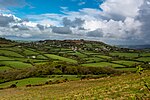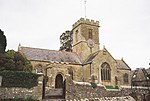Chideock

Chideock ( CHID-ək) is a village and civil parish in south west Dorset, England, situated close to the English Channel between Bridport and Lyme Regis. Dorset County Council's 2013 estimate of the parish population is 550. Chideock's economy mostly comprises agriculture (arable and pastoral) and tourism. The parish includes part of the Jurassic Coast, a World Heritage Site. During much of its history Chideock has had a strong tradition of Catholicism; in the late 16th century four Chideock men were executed for their faith and became known as the Chideock Martyrs. There is a memorial to the men in the village. The A35 trunk road passes through the village, which means the main street can have high volumes of traffic.
Excerpt from the Wikipedia article Chideock (License: CC BY-SA 3.0, Authors, Images).Chideock
North Road,
Geographical coordinates (GPS) Address Nearby Places Show on map
Geographical coordinates (GPS)
| Latitude | Longitude |
|---|---|
| N 50.7324 ° | E -2.8208 ° |
Address
North Road
DT6 6SA
England, United Kingdom
Open on Google Maps









